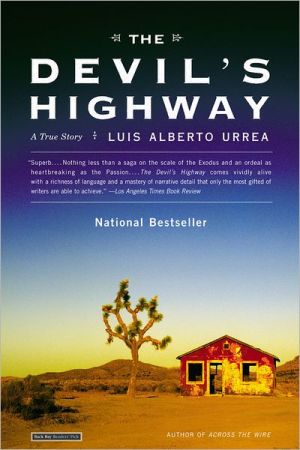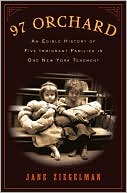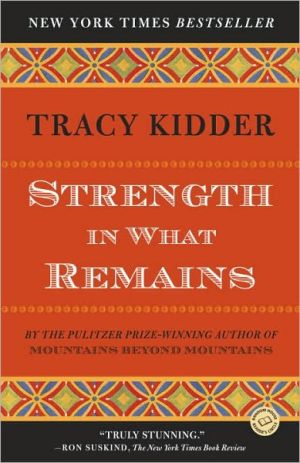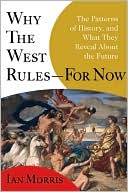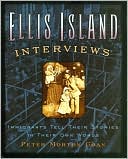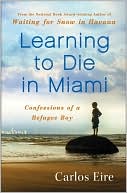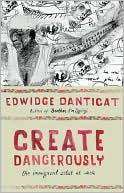The Devil's Highway: A True Story
The author of "Across the Wire" offers brilliant investigative reporting of what went wrong when, in May 2001, a group of 26 men attempted to cross the Mexican border into the desert of southern Arizona. Only 12 men came back out. "Superb . . . Nothing less than a saga on the scale of the Exodus and an ordeal as heartbreaking as the Passion . . . The book comes vividly alive with a richness of language and a mastery of narrative detail that only the most gifted of writers are able to...
Search in google:
The author of "Across the Wire" offers brilliant investigative reporting of what went wrong when, in May 2001, a group of 26 men attempted to cross the Mexican border into the desert of southern Arizona. Only 12 men came back out. "Superb . . . Nothing less than a saga on the scale of the Exodus and an ordeal as heartbreaking as the Passion . . . The book comes vividly alive with a richness of language and a mastery of narrative detail that only the most gifted of writers are able to achieve.—"Los Angeles Times Book Review." The Washington Post Urrea, a poet and novelist who is also a dogged reporter on the border wars, is keenly attuned to such eloquent and awful ironies and uses them to punctuate the The Devil's Highway, a painstaking, unsentimental and oddly lyrical chronology of the traveling party's horrific trek through the Sonora. — Chris Lehmann
The Devil's Highway\ A True Story \ \ By Luis Alberto Urrea \ Little, Brown\ Copyright © 2004 Luis Urrea\ All right reserved.\ ISBN: 0-316-74671-1 \ \ \ Chapter One\ The Rules of the Game \ Five men stumbled out of the mountain pass so sunstruck they didn't know their own names, couldn't remember where they'd come from, had forgotten how long they'd been lost. One of them wandered back up a peak. One of them was barefoot. They were burned nearly black, their lips huge and cracking, what paltry drool still available to them spuming from their mouths in a salty foam as they walked. Their eyes were cloudy with dust, almost too dry to blink up a tear. Their hair was hard and stiffened by old sweat, standing in crowns from their scalps, old sweat because their bodies were no longer sweating. They were drunk from having their brains baked in the pan, they were seeing God and devils, and they were dizzy from drinking their own urine, the poisons clogging their systems.\ They were beyond rational thought. Visions of home fluttered through their minds. Soft green bushes, waterfalls, children, music. Butterflies the size of your hand. Leaves and beans of coffee plants burning through the morning mist as if lit from within. Rivers. Not like this place where they'd gotten lost. Nothing soft here. This world of spikes and crags was as alien to them as if they'd suddenly awakened on Mars. They had seen cowboys cut open cacti to find water in the movies, but they didn't know what cactus among the many before them might hold some hope. Men tore their faces open chewing saguaros and prickly pears, leaving gutted plants that looked like animals had torn them apart with their claws. The green here was gray.\ They were walking now for water, not salvation. Just a drink. They whispered it to each other as they staggered into parched pools of their own shadows, forever spilling downhill before them: Just one drink, brothers. Water. Cold water! They walked west, though they didn't know it; they had no concept anymore of destination. The only direction they could manage was through the gap they stumbled across as they cut through the Granite Mountains of southern Arizona. Now canyons and arroyos shuffled them west, toward Yuma, though they didn't know where Yuma was and wouldn't have reached it if they did.\ They came down out of the screaming sun and broke onto the rough plains of the Cabeza Prieta wilderness, at the south end of the United States Air Force's Barry Goldwater bombing range, where the sun recommenced its burning. Cutting through this region, and lending its name to the terrible landscape, was the Devil's Highway, more death, another desert. They were in a vast trickery of sand.\ In many ancient religious texts, fallen angels were bound in chains and buried beneath a desert known only as Desolation. This could be the place.\ In the distance, deceptive stands of mesquite trees must have looked like oases. Ten trees a quarter mile apart can look like a cool grove from a distance. In the western desert, twenty miles looks like ten. And ten miles can kill. There was still no water; there wasn't even any shade.\ Black ironwood stumps writhed from the ground. Dead for five hundred years, they had already been two thousand years old when they died. It was a forest of eldritch bones. The men had cactus spines in their faces, their hands. There wasn't enough fluid left in them to bleed. They'd climbed peaks, hoping to find a town, or a river, had seen more landscape, and tumbled down the far side to keep walking. One of them said, "Too many damned rocks." Pinches piedras, he said. Damned heat. Damned sun.\ Now, as they came out of the hills, they faced the plain and the far wall of the Gila Mountains. Mauve and yellow cliffs. A volcanic cone called Raven's Butte that was dark, as if a rain cloud were hovering over it. It looked as if you could find relief on its perpetually shadowy flanks, but that too was an illusion. Abandoned army tanks, preserved forever in the dry heat, stood in their path, a ghostly arrangement that must have seemed like another bad dream. Their full-sun 110-degree nightmare.\ "The Devil's Highway" is a name that has set out to illuminate one notion: bad medicine.\ The first white man known to die in the desert heat here did it on January 18, 1541.\ Most assuredly, others had died before. As long as there have been people, there have been deaths in the western desert. When the Devil's Highway was a faint scratch of desert bighorn hoof marks, and the first hunters ran along it, someone died. But the brown and red men who ran the paths left no record outside of faded songs and rock paintings we still don't understand.\ Desert spirits of a dark and mysterious nature have always traveled these trails. From the beginning, the highway has always lacked grace-those who worship desert gods know them to favor retribution over the tender dove of forgiveness. In Desolation, doves are at the bottom of the food chain. Tohono O'Odham poet Ofelia Zepeda has pointed out that rosaries and Hail Marys don't work out here. "You need a new kind of prayers," she says, "to negotiate with this land."\ The first time the sky and earth came together, Elder Brother, I'itoi, was born. He still resides in a windy cave overlooking the western desert, and he resents uninvited visitors. Mountains are called do'ags. In the side of one do'ag can be found the twin caves where the spirit of the evil witch, Ho'ok, hides. The coyote-spirit of the place is called Ban, and he works his wicked pranks in the big open spaces.\ Everywhere, red shadows. Tiny men live underground, and they are known to the Yaqui Indians hereabouts as Surem. In the past, before the first white man died, uku, the devil, controlled all the corn until the crows stole it from him and let some of it slip so men could eat. Mexico's oldest hoodoo, La Llorona, the wailing ghost, has been heard rushing down nearby creek beds. And its newest hoodoo, the dreaded Chupacabras (the Goat Sucker), has been seen attacking animals, lurking in outhouses, and even jumping in bedroom windows to munch on sleeping children. An Apache witness said the Chupacabras was a whispering kangaroo. It said, "Come here." He swore it did.\ The plants are noxious and spiked. Saguaros, nopales, the fiendish chollas. Each long cholla spike has a small barb, and they hook into the skin, and they catch in elbow creases and hook forearm and biceps together. Even the green mesquite trees have long thorns set just at eye level.\ Much of the wildlife is nocturnal, and it creeps through the nights, poisonous and alien: the sidewinder, the rattlesnake, the scorpion, the giant centipede, the black widow, the tarantula, the brown recluse, the coral snake, the Gila monster. The kissing bug bites you and its poison makes the entire body erupt in red welts. Fungus drifts on the valley dust, and it sinks into the lungs and throbs to life. The millennium has added a further danger: all wild bees in southern Arizona, naturalists report, are now Africanized. As if the desert felt it hadn't made its point, it added killer bees.\ Today, the ancient Hohokam have vanished, like the Anasazi, long gone in the north. Their etchings and ruins still dot the ground; unexplained radiating lines lead away from the center like ghost roads in the shape of a great star. Not all of these paths are ancient. Some of the lines have been made by the illegals, cutting across the waste to the far lights of Ajo, or Sells, or the Mohawk rest area on I-8. Others are old beyond dating, and no one knows where they lead. Footprints of long-dead cowboys are still there, wagon ruts and mule scuffs. And beneath these, the prints of the phantom Hohokam themselves.\ In certain places, boulders form straight lines, arrayed along compass directions on the burning plains. Among these stones are old rock piles in the shapes of arrows. They were left by well-wishers in 1890, aiming at a tinaja (water hole) hidden among crags. Cairns that serve as mysterious signposts for messages long forgotten mix with ancient graves. Etchings made in the hardpan with feet or sticks form animals centuries old and only visible from the air. Some of these cairns have been put in place by Border Patrol signcutters (trackers), and they are often at the junction of two desert paths, but the cutters just smile when you ask what they mean. One more secret of Desolation.\ When the white men came, they brought with them their mania for record keeping. They made their way across the land, subduing indigenous tribes, civilizing the frontier. Missionaries brought the gentle word of the Lamb. Cavalrymen bravely tamed the badlands, built military outposts, settlements, ranches, and towns. Cowboys rode like the wind. Gunslingers fell. The worst bandits you could imagine drank rotgut and shot sheriffs, yet lived on in popular mythology and became the subjects of popular songs and cheap fictions. Railroads followed, and the great cattle drives, and the dusty range wars, and the discovery of gold and silver. In the great north woods, lumberjacks collected the big trees. The Alamo. The Civil War took out countless citizens in its desperate upheaval.\ Every Tijuana schoolkid knows it: it's the history of Mexico.\ If the North American continent was broad ("high, wide, and lonesome"), then Mexico was tall. High, narrow, and lonesome. Europeans conquering North America hustled west, where the open land lay. And the Europeans settling Mexico hustled north. Where the open land was.\ Immigration, the drive northward, is a white phenomenon. White Europeans conceived of and launched El Norte mania, just as white Europeans inhabiting the United States today bemoan it. They started to complain after the Civil War. The first illegal immigrants to be hunted down in Desolation by the earliest form of the Border Patrol were Chinese. In the 1880s, American railroad barons needed cheap skilled labor to help "tame our continent." Mexico's Chinese hordes could be hired for cheap, yet they could earn more in the United States than in Mexico, even at cut rates. Jobs opened, word went out, the illegals came north. Sound familiar?\ Americans panicked at the "yellowing" of America. A force known as the Mounted Chinese Exclusionary Police took to the dusty wasteland. They chased the "coolies" and deported them. And today?\ Sinful frontier towns with bad reputations. Untamed mountain ranges, bears, lions, and wolves. Indians. A dangerous border. Inhabitants speak with a cowpoke twang, listen to country music, dance the two-step, favor cowboy hats, big belt buckles, and pickup trucks. That ain't Texas, it's Sonora.\ January 18,1541.\ Sonoita (also known as Sonoyta) was perhaps not much more than sticks and mud, but it was a stopping point for a Spanish expedition in search of, what else, gold. Even in 1541, Sonoita was the unwilling host of killers and wanderers. The leader of this clanking Spaniard patrol was a firebrand known as Melchior Diaz. He didn't especially want to spend his holidays in the broiling dust of Sonoita, but he was deep into hostile territory. It was commonly believed that the natives of the Devil's Highway devoured human children. The Spaniards weren't planning on settling-spread the cross around, throw up a mission, and hit the road in search of better things.\ Melchior Diaz was trying to reach the Sea of Cortez, lying between the Mexican mainland and Baja California. Perhaps he knew that ahead of him lay the most hellish stretch of land in the entire north. The dirt paths he rode his horse down on that day are now the paved and semipaved barrio lanes of modern Sonoita. Some of the hubcap-popping boulders in Sonoita's hillside alleys are the same rocks on which Melchior's horse's shoes struck sparks.\ He died trying to kill a dog. He probably didn't have anything against canines-his troop had dogs that they used to hunt down game and humans. But there were also the feral creatures that dashed in from the out-skirts of the settlement to slaughter his sheep. Melchior Diaz kept his sheep in small brush corrals, attended by his Indian slaves. But the wild dogs had a way of sneaking off with lambs when nobody was looking.\ And Melchior was cranky. He had spent his holidays far from home, among the savages, and even Tucson was only a small scattering of huts and lean-tos. He couldn't have been farther from Mexico City or Spain. Sonoita was the end of the world. A Christmas in this outpost did not inspire joy. Besides, conquistadores were notoriously short on joie de vivre.\ Melchior rode well, and he rode well armed. He certainly carried a sword and a fighting dagger. He probably carried a harquebus and a long metal-tipped lance, the M16 of the day.\ Melchior was a strong man and a powerful fighter. In the narratives of the Coronado expedition, we see him plying his trade: "... the horsemen began to overtake [the Indians] and the lances cut them down mercilessly ... until not a man was to be seen." This rout of natives serves as the preface to the story of death that begins with Melchior Díaz.\ We know that he was riding his horse down one of the settlement paths. We can project the smells swirling around him: horse, dirt, his own stink, chickens, smoke, dung. Not all that different from the smells of today.\ He was approaching his sheep pen, perhaps where the Asi Es Mi Tierra taco shop, or a Pemex station stands today. Melchior squinted ahead and-Damn it to hell!-those lazy slaves of his had allowed a dog to get in the pen!\ Perro desgraciado!\ No record states how Melchior entered the pen, but it doesn't seem likely he stopped to open a gate. Not Melchior. He jumped over the fence, and in jumping, somehow he bobbled his lance throw and missed the dog entirely. You can see the dog yipping and sidestepping and making tracks for the horizon, casting wounded looks over his shoulder. And here is where Melchior Diaz died. The record states that Melchior, somehow, "passed over" the lance. Did he fall from the horse? No one knows, but the lance managed to penetrate his gut and rip him open.\ The desert ground must have seemed terribly hard as he hit it. As Melchior died (it took twenty gruesome days)on his stinking cot, he burned and howled. Flies settled in his entrails. Maybe the very dog that killed him drew near to sniff the rich meaty scent. The fallen angels of Desolation came out of the Cabeza Prieta, folded their hands over him, and smiled.\ The land had been haunted before Melchior died, and it remained haunted afterward; 150 years after his death, Catholic apparitions plagued the tribes. Various peoples had alarming encounters with meddlesome white women who flew above their heads. In the lands of the O'Odham, a white woman bearing a cross came drifting down the Devil's Highway itself. The warriors who saw her immediately did the only practical thing they could: they filled her with arrows. They said she refused to die. Kept on flying.\ \ Continues...\ \ \ \ Excerpted from The Devil's Highway by Luis Alberto Urrea Copyright © 2004 by Luis Urrea. Excerpted by permission.\ All rights reserved. No part of this excerpt may be reproduced or reprinted without permission in writing from the publisher.\ Excerpts are provided by Dial-A-Book Inc. solely for the personal use of visitors to this web site. \ \
\ From Barnes & NobleIn 2001, 26 men slipped across the Mexican border, traveling on foot across Arizona's deadly clandestine "Devil's Highway." Fewer than half of these hapless migrants would survive the scorching passage. In this gripping book, American Book Award winner Luis Alberto Urrea tells the story of the deadly trek, the hapless immigrants, and the Border Patrol units who hunt them.\ \ \ \ \ The Washington PostUrrea, a poet and novelist who is also a dogged reporter on the border wars, is keenly attuned to such eloquent and awful ironies and uses them to punctuate the The Devil's Highway, a painstaking, unsentimental and oddly lyrical chronology of the traveling party's horrific trek through the Sonora. — Chris Lehmann\ \ \ Publishers WeeklyIn May 2001, 26 Mexican men scrambled across the border and into an area of the Arizona desert known as the Devil's Highway. Only 12 made it safely across. American Book Award-winning writer and poet Urrea (Across the Wire; Six Kinds of Sky; etc.), who was born in Tijuana and now lives outside Chicago, tracks the paths those men took from their home state of Veracruz all the way norte. Their enemies were many: the U.S. Border Patrol ("La Migra"); gung-ho gringo vigilantes bent on taking the law into their own hands; the Mexican Federales; rattlesnakes; severe hypothermia and the remorseless sun, a "110 degree nightmare" that dried their bodies and pounded their brains. In artful yet uncomplicated prose, Urrea captivatingly tells how a dozen men squeezed by to safety, and how 14 others whom the media labeled the Yuma 14 did not. But while many point to the group's smugglers (known as coyotes) as the prime villains of the tragedy, Urrea unloads on, in the words of one Mexican consul, "the politics of stupidity that rules both sides of the border." Mexican and U.S. border policy is backward, Urrea finds, and it does little to stem the flow of immigrants. Since the policy results in Mexicans making the crossing in increasingly forbidding areas, it contributes to the conditions that kill those who attempt it. Confident and full of righteous rage, Urrea's story is a well-crafted m lange of first-person testimony, geographic history, cultural and economic analysis, poetry and an indictment of immigration policy. It may not directly influence the forces behind the U.S.'s southern border travesties, but it does give names and identities to the faceless and maligned "wetbacks" and "pollos," and highlights the brutality and unsustainable nature of the many walls separating the two countries. Maps not seen by PW. (Apr. 2) Forecast: Urrea has received coverage for his previous writing projects in numerous arts-related publications and has a loyal fan base. A six-city author tour and radio interviews will expand his audience further. The book has been optioned as the debut movie of Tucson-based Creative Dreams Inc. and is scheduled to begin filming in October 2004. Copyright 2004 Reed Business Information.\ \ \ \ \ Library JournalIn May 2001, 26 Mexican men died in a section of the Arizona desert dubbed the Devil's Highway. Urrea, employing some journalistic license, paints a grim picture of the deadly struggle of those trying to enter the United States illegally and those working equally hard to secure the borders. This cat-and-mouse game between smugglers ("coyotes") and the U.S. Border Patrol ("La Migra") requires intelligence, creativity, endurance, experience, and luck. As the borders in urban areas became harder to cross, those sneaking illegals into "El Norte" have gone farther into the remote desert. The research here is excellent, and Urrea's narration is impressive. The story unfolds in a way that is fascinating to the listener—you can almost feel the heat and smell the desperation. A complex issue is covered with style, making this a recommended title for true crime collections and those interested in immigration. [The Little, Brown hc was a national best seller.—Ed.]—Scott R. DiMarco, Mansfield Univ. of Pennsylvania Lib.\ \ \ \ \ Kirkus ReviewsThe rueful, fate-wracked tale of 26 men who tried to cross into the US from Mexico but chose the wrong time, place, and guide. More than half would die, turned to cinder in the sun-blasted desert of southern Arizona. American Book Award-winner Urrea (Wandering Time, 1999, etc.) tells this grim story wonderfully; like the Border Patrol's trackers, he cuts back and forth, looking for signs, following tracks wherever they might lead. This means relating the various biographies of the "walkers" themselves and discovering what drove them north, from the desire for a new life to a season's work in the orange groves to a job putting a new roof on a house. It means delving into the disastrous Mexican state, with its "catastrophic political malfeasance that forced the walkers to flee their homes and bake to death in the western desert." Urrea notes the shift in tactics, thanks to the Border Patrol's extremely effective interdiction and prevention policies, which now compel guides to take walkers over the most remote and dangerous routes. They will often be abandoned if the going gets too tough, as happened here. Urrea spends time in the ratty border hotels and towns ("Sonoita smells like bad fruit and sewage. Blue clouds of exhaust leak from the dying cars"), and he spends time with the Patrol, especially the trackers, who can read so much from a footprint that it's scary. But not as scary as hyperthermia and its ugly progress: the first stages of stress and fatigue, on through syncope and cramps, to the dreadful sludge of exhaustion and stroke. This is not the peaceful sleep-death brought on by freezing; it's reeling and raging, and when a man's son dies in his arms, "the father lurched away intothe desert, away from the trees, crying out in despair." A horrendous story told with bitter skill, highlighting the whole sordid, greedy mess that attends illegal broader crossings. Agent: Sandy Dijkstra/Sandra Dijkstra Agency\ \
